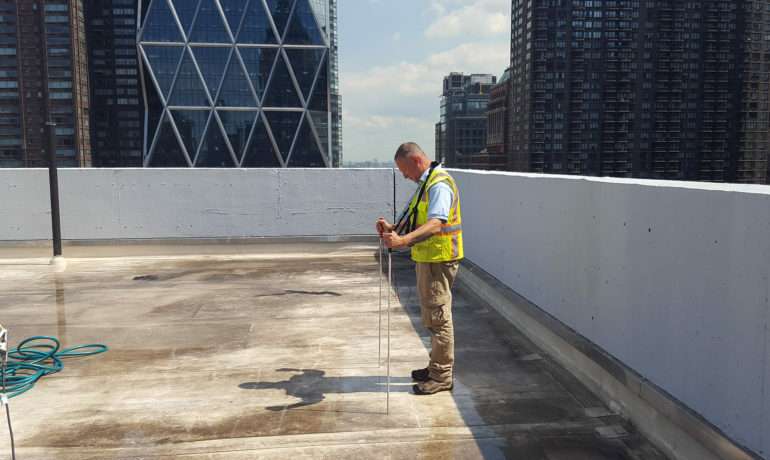Your building’s roof is designed to keep the elements outside, but every roof system fails over time. Maintaining your building’s envelope and fixing leaks before they get too severe is crucial for protecting your property, as well as the contents and equipment inside. For years, flood testing was the primary method of detecting commercial roof leaks, but we’re going to talk about electronic leak detection and why it may be a better option for your building.
What is Electronic Leak Detection?
Electronic leak detection (ELD) is a method of testing a roof to find weak spots or pinpoint the origin of a leak. ELD involves probes that pass electricity most readily through damaged areas of roofing. There are two kinds of ELD: low-voltage and high-voltage.
Low-Voltage Testing
In low-voltage testing, the roof is wet down with a very thin layer of water. A field or number of fields are then created, typically no more than 7500 SF each.– A generator emitting a low voltage current is then passed over the wet area or “field” in a grid pattern, testing the entire membrane. The wire used to create the field, is connected to a ground or reference, typically the conductive decking. When a breach or thin spot is located, it will trigger an audible sound.
This method relies quite a bit on the technician’s experience, and results vary depending on the roofing material. This is what we describe as both art and science.
High-Voltage Testing
High-voltage testing is similar, but it’s done with a dry roof. A conductive bristle broom or brush emitting high voltage (yet very low amperage or milliamps) current is passed over the entire roofing membrane, and wet building materials beneath the surface – a clear sign of a leak – will complete the circuit and alert the technician.
This method is highly accurate, can pinpoint leaks on horizontal and vertical surfaces, and can even detect thin areas that haven’t started leaking yet.
Why Electronic is Better Than Flood Testing
ELD is superior to flood testing for a few key reasons. First, it’s more accurate. Flood testing can alert you that you have a leak, but ELD will show you exactly where the leak is, minimizing the area you need to repair and the overall cost.
Additionally, flood testing requires large amounts of water pumped up onto your roof. This can not only make leaks worse and cause additional damage inside your building, but the weight of the water can cause additional damage as well.
Although a popular testing method for a long time, flood testing is outdated, inaccurate, and potentially dangerous to your property. If you’re looking for an accurate way to locate a roof leak, or you want to test your roof for potential weak spots to minimize repair costs in the long run, contact one of our highly-trained professionals to discuss how ELD can benefit you and your building.

